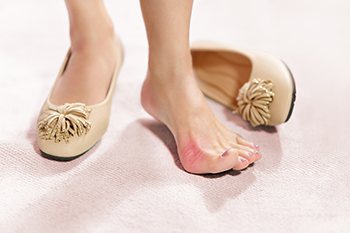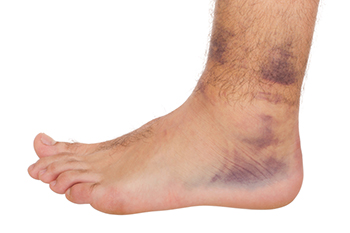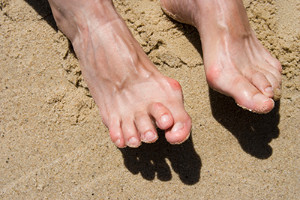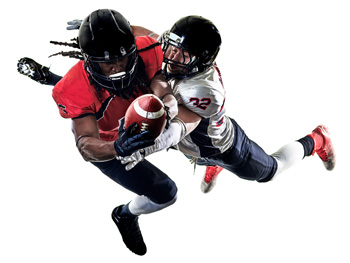Douglas Pacaccio, DPM
Thomas Nordquist, DPM
August 2022
Reasons a Bunion Can Develop

A bump on the side of the big toe may be classified as a bunion. It can be large or small depending on how fast it develops. It may be uncomfortable and can happen as a result of wearing shoes that do not have adequate room for the toes to move around in. Some patients have pain in the bottom of their big toe that may gradually develop into the rest of the foot. In severe cases, the bunion may cause the other toes to shift and can result in overlapping. Many patients choose to have an X-ray taken and this can be beneficial in determining the extent of the deformity, in addition to observing if there is wear and tear on the joint. This condition may be the result of an abnormal foot structure and may happen to people who have flat feet. Additional reasons why people may develop a bunion can be from having endured a foot injury or possibly from collagen deficiency diseases. If you have a bunion, please confer with a podiatrist who can recommend what type of treatment is correct for you, and how to find permanent relief.
If you are suffering from bunion pain, contact one of our podiatrists of Advanced Foot and Ankle Surgeons, Inc. . Our doctors can provide the care you need to keep you pain-free and on your feet.
What Is a Bunion?
Bunions are painful bony bumps that usually develop on the inside of the foot at the joint of the big toe. As the deformity increases over time, it may become painful to walk and wear shoes. Women are more likely to exacerbate existing bunions since they often wear tight, narrow shoes that shift their toes together. Bunion pain can be relieved by wearing wider shoes with enough room for the toes.
Causes
- Genetics – some people inherit feet that are more prone to bunion development
- Inflammatory Conditions - rheumatoid arthritis and polio may cause bunion development
Symptoms
- Redness and inflammation
- Pain and tenderness
- Callus or corns on the bump
- Restricted motion in the big toe
In order to diagnose your bunion, your podiatrist may ask about your medical history, symptoms, and general health. Your doctor might also order an x-ray to take a closer look at your feet. Nonsurgical treatment options include orthotics, padding, icing, changes in footwear, and medication. If nonsurgical treatments don’t alleviate your bunion pain, surgery may be necessary.
If you have any questions, please feel free to contact one of our offices located in Sycamore, and Yorkville, IL . We offer the newest diagnostic and treatment technologies for all your foot care needs.
Typical Pregnancy Foot Problems

Although it might not seem immediately intuitive to some pregnant women, pregnancy can seriously impact and affect the feet. While a baby grows inside a pregnant woman, the woman’s center of gravity changes, forcing the feet to adapt. Additionally, during pregnancy, the woman produces a variety of pregnancy hormones that can have significant effects on the feet. One typical problem that you might encounter during your pregnancy is flat feet. Flat feet occur when the feet lose their natural arch and the entire foot presses directly against the ground when standing. Pregnant women can sometimes develop flat feet because as they gain a notable amount of weight, they exert more and more pressure on the feet, which can reduce the arch in the feet. Secondly, another common pregnancy foot problem is swelling in the feet. Swollen feet can frequently occur in pregnant women because, throughout the pregnancy, the pregnant woman’s body must produce a significantly larger amount of blood to support the growing baby. This excess of blood and fluids might sometimes lead to swelling in the feet. As a result, you might notice your foot size increasing, causing your feet to temporarily require larger shoes. If you are pregnant, it might be a good idea to reach out to your podiatrist who can help you manage symptoms on your feet.
Pregnant women with swollen feet can be treated with a variety of different methods that are readily available. For more information about other cures for swollen feet during pregnancy, consult with one of our podiatrists from Advanced Foot and Ankle Surgeons, Inc. . Our doctors will attend to all of your foot and ankle needs.
What Foot Problems Can Arise During Pregnancy?
One problem that can occur is overpronation, which occurs when the arch of the foot flattens and tends to roll inward. This can cause pain and discomfort in your heels while you’re walking or even just standing up, trying to support your baby.
Another problem is edema, or swelling in the extremities. This often affects the feet during pregnancy but tends to occur in the later stages.
How Can I Keep My Feet Healthy During Pregnancy?
- Wearing orthotics can provide extra support for the feet and help distribute weight evenly
- Minimize the amount of time spent walking barefoot
- Wear shoes with good arch support
- Wear shoes that allow for good circulation to the feet
- Elevate feet if you experience swelling
- Massage your feet
- Get regular, light exercise, such as walking, to promote blood circulation to the feet
If you have any questions please feel free to contact one of our offices located in Sycamore, and Yorkville, IL . We offer the newest diagnostic and treatment technologies for all your foot and ankle needs.
Facts About Sprained Ankles

Most sprained ankles occur when the ankle rolls outward as the foot twists inward. This causes the ligaments on the outside of the ankle to stretch and possibly tear. With a mild sprain, the ankle may be sore and stiff. It may swell slightly, but you should be able to walk with minor pain. As the severity of the sprain increases, your ankle may become bruised and tender, making walking far more painful. With a severe sprain, the ankle joint will feel unstable, and bearing weight is not possible. Ankle sprains can take a while to heal, but this long process is important to avoid re-spraining the ankle or developing chronic ankle problems. If you hear a popping sound at the time of the sprain, please see a podiatrist immediately. You will undergo an exam and be given a treatment schedule that may include pain medication, exercises, or bracing to protect the joint and allow it to heal properly. In some cases surgery may be required.
Although ankle sprains are common, they aren’t always minor injuries. If you need your ankle injury looked at, contact one of our podiatrists from Advanced Foot and Ankle Surgeons, Inc. . Our doctors can provide the care you need to keep you pain-free and on your feet.
How Does an Ankle Sprain Occur?
Ankle sprains are the result of a tear in the ligaments within the ankle. These injuries may happen when you make a rapid shifting movement while your foot is planted. A less common way to sprain your ankle is when your ankle rolls inward while your foot turns outward.
What Are the Symptoms?
- Pain at the sight of the tear
- Bruising/Swelling
- Ankle area is tender to touch
- In severe cases, may hear/feel something tear
- Skin discoloration
Preventing a Sprain
- Wearing appropriate shoes for the occasion
- Stretching before exercises and sports
- Knowing your limits
Treatment of a Sprain
In many cases, the RICE method (Rest, Ice, Compression, and Elevate) is used to treat ankle sprains. However, you should see a podiatrist to see which treatment option would work best with your injury. In severe cases, surgery may be required.
It is important to ask your doctor about rehab options after you receive treatment for your injury. Stretching, strength training, and balance exercises may help the ankle heal while also preventing further injury.
If you have any questions, please feel free to contact one of our offices located in Sycamore, and Yorkville, IL . We offer the newest diagnostic and treatment technologies for all your foot care needs.
Dealing With a Hammertoe

A hammertoe is when a toe is stuck in an upward bent position at the middle of a joint. The top of the toe is bent forward and looks like a hammer, hence its name. It is one of the most common deformities of the forefoot and can affect balance as well as cause pain and trouble with walking and other activities. Hammertoes can happen when the small muscles on the bottom of the feet (intrinsic muscles) are weaker than the larger muscles on the top of the foot (extrinsic muscles). Hammertoe can often be a result of other issues, such as having flat feet with longer metatarsals or middle foot bones, having a bunion, having a medical condition such as diabetes or inflammatory arthropathies that affect muscles, tendons, and nerves in the feet, and wearing shoes that are too narrow or tight, forcing the toes down into the tip of the shoe. Beyond pain, if you have a hammertoe, you may experience swelling or redness of the toe, callus formation on the parts of the toe that rub against the shoe, and changes in walking patterns. Treatment includes wearing properly fitted shoes with wide toe boxes, doing toe stretching and other exercises to build up the strength of the intrinsic muscles of the foot, wearing cushions, pads, or insoles, taping, and possibly surgery. Early intervention is more likely to work since the toe joint will be more apt to be flexible. If you feel you have a hammertoe, and particularly if it is causing you discomfort, talk with a podiatrist about treatment that might work best for you.
Hammertoes can be a painful condition to live with. For more information, contact one of our podiatrists of Advanced Foot and Ankle Surgeons, Inc. . Our doctors will answer any of your foot- and ankle-related questions.
Hammertoe
Hammertoe is a foot deformity that occurs due to an imbalance in the muscles, tendons, or ligaments that normally hold the toe straight. It can be caused by the type of shoes you wear, your foot structure, trauma, and certain disease processes.
Symptoms
- Painful and/or difficult toe movement
- Swelling
- Joint stiffness
- Calluses/Corns
- Physical deformity
Risk Factors
- Age – The risk of hammertoe increases with age
- Sex – Women are more likely to have hammertoe compared to men
- Toe Length – You are more likely to develop hammertoe if your second toe is longer than your big toe
- Certain Diseases – Arthritis and diabetes may make you more likely to develop hammertoe
Treatment
If you have hammertoe, you should change into a more comfortable shoe that provides enough room for your toes. Exercises such as picking up marbles may strengthen and stretch your toe muscles. Nevertheless, it is important to seek assistance from a podiatrist in order to determine the severity of your hammertoe and see which treatment option will work best for you.
If you have any questions, please feel free to contact one of our offices located in Sycamore, and Yorkville, IL . We offer the newest diagnostic and treatment technologies for all your foot care needs.
Why Live with Pain and Numbness in Your Feet?
Common Foot and Ankle Injuries From Football

Football foot and ankle injuries can be sustained while running, side-to-side cutting, direct contact with another player, and/or falls. Injuries most common in football include ankle sprains, tendon injuries, fractures to ankles, feet, and toes, bone bruises, plantar fasciitis, tendonitis, and sesamoiditis. Other injuries, such as turf toe, occur most often when playing football than anywhere else. Turf toe is a common injury among both football and soccer players who play on artificial turf. Repeated pushing off of the big toe while on hard surfaces can cause stress to the joints and ligaments and lead them to eventually overstretch or tear. Wearing proper footwear for the game, warming up, and remaining alert will help prevent football injuries, but they may happen anyway. If you play football and experience an injury or any foot or ankle pain that does not get better with rest, see a podiatrist for proper diagnosis and treatment.
Ankle and foot injuries are common among athletes and in many sports. They can be caused by several problems and may be potentially serious. If you are feeling pain or think you were injured in a sporting event or when exercising, consult with one of our podiatrists from Advanced Foot and Ankle Surgeons, Inc. . Our doctors will assess your condition and provide you with quality foot and ankle treatment.
Common Injuries
The most common injuries that occur in sporting activities include:
- Achilles Tendonitis
- Achilles Tendon Rupture
- Ankle Sprains
- Broken Foot
- Plantar Fasciitis
- Stress Fractures
- Turf Toe
Symptoms
Symptoms vary depending upon the injury and in some cases, there may be no symptoms at all. However, in most cases, some form of symptom is experienced. Pain, aching, burning, bruising, tenderness, tightness or stiffness, sensation loss, difficulty moving, and swelling are the most common symptoms.
Treatment
Just as symptoms vary depending upon the injury, so do treatment options. A common treatment method is known as the RICE method. This method involves rest, applying ice, compression and elevating the afflicted foot or ankle. If the injury appears to be more serious, surgery might be required, such as arthroscopic or reconstructive surgery. Lastly, rehabilitation or therapy might be needed to gain full functionality in the afflicted area. Any discomfort experienced by an athlete must be evaluated by a licensed, reputable medical professional.
If you have any questions, please feel free to contact one of our offices located in Sycamore, and Yorkville, IL . We offer the newest diagnostic and treatment technologies for all your foot care needs.
Blog Archives
- July 2024
- June 2024
- May 2024
- April 2024
- March 2024
- February 2024
- January 2024
- December 2023
- November 2023
- October 2023
- September 2023
- August 2023
- July 2023
- June 2023
- May 2023
- April 2023
- March 2023
- February 2023
- January 2023
- December 2022
- November 2022
- October 2022
- September 2022
- August 2022
- July 2022
- June 2022
- May 2022
- April 2022
- March 2022
- February 2022
- January 2022
- December 2021
- November 2021
- October 2021
- September 2021
- August 2021
- July 2021
- June 2021
- May 2021
- April 2021
- March 2021
- February 2021
- January 2021
- December 2020
- November 2020
- October 2020
- September 2020
- August 2020
- July 2020
- June 2020
- May 2020
- April 2020
- March 2020
- February 2020
- January 2020
- December 2019
- November 2019
- October 2019
- September 2019
- August 2019
- July 2019
- June 2019
- May 2019
- April 2019
- March 2019
- February 2019
- January 2019
- December 2018
- November 2018
- October 2018
- September 2018









